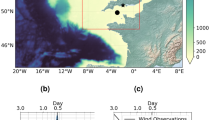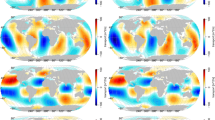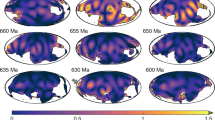Abstract
DOUGLAS et al.1 demonstrated the existence of an apparent latitude dependence of tidal friction by determining disparate values of the second degree Love number (k2) from perturbations of the inclinations of the GEOS-1 and GEOS-2 satellites. Lambeck et al.2 correctly explained this phenomenon as being due to neglect of ocean tide perturbations. Parameter values for some ocean tide components have been obtained from several satellites3, but parameter values for the M2 tide, the dominant (85%) effect of the oceans on the tidal acceleration of the Moon, have not been published. Using an improved method for computing mean elements, we4 obtained an observation equation for the M2 tide from the satellite 1967-92A. Applying this technique to the satellite GEOS-3, we now obtain an additional observation equation for the M2 tide. As shown in ref. 2, solid and fluid tide effects on satellites cannot be separated, requiring assumption of the solid tide amplitude and phase parameters for a fluid tide solution. Assuming k2 = 0.30, δ2 = 0°, and using the values of Lambeck5 for the minor O1 and N2, contributions to ṅt, our fluid tide parameters for the M2 ocean tide yield the value of the tidal acceleration ṅt = −27.4±3 arc s (100 yr)−2, in excellent agreement with the value ṅt = −27.2±1.7 arc s (100 yr)−2 obtained by Muller6 from a combination of ancient and modern observations. These two values are lower than the value ṅt = −35±4 arc s (100 yr)−2 obtained from numerical ocean tide models5. Our assumption of a negligible solid tide phase angle is supported by a recent determination by J. T. Kuo (personal communication) that the phase angle obtained from a transcontinental network of tidal gravimetric stations is < 1°. Changes ⩽ 0.5° in solid tide phase angle change our result for the combined solid/fluid ṅt by no more than 1 arc s per (100 yr) (ref. 2).
This is a preview of subscription content, access via your institution
Access options
Subscribe to this journal
Receive 51 print issues and online access
$199.00 per year
only $3.90 per issue
Buy this article
- Purchase on Springer Link
- Instant access to full article PDF
Prices may be subject to local taxes which are calculated during checkout
Similar content being viewed by others
References
Douglas, B. C., Klosko, S. M., Marsh, J. G. & Williamson, R. G. Celestial Mechanics 10, 165–168 (1974).
Lambeck, K., Cazenave, A. & Balmino, G., Rev. Geophys. Space Phys. 12, 421–434 (1974).
Felsentreger, T. L., Marsh, J. G. & Agreen, R. W. J. geophys. Res. 81, 2557–2563 (1976).
Goad, C. C. & Douglas, B. C. J. geophys. Res. 82, 898–900 (1977).
Lambeck, K. J. geophys. Res. 80, 2917–2925 (1975).
Muller, P. M., Jet Propulsion Laboratory Special Rep. JPL SP 43-36 (1976)
Author information
Authors and Affiliations
Rights and permissions
About this article
Cite this article
GOAD, C., DOUGLAS, B. Tidal acceleration of the moon deduced from observations of artificial satellites. Nature 266, 514–515 (1977). https://doi.org/10.1038/266514b0
Received:
Accepted:
Issue Date:
DOI: https://doi.org/10.1038/266514b0
Comments
By submitting a comment you agree to abide by our Terms and Community Guidelines. If you find something abusive or that does not comply with our terms or guidelines please flag it as inappropriate.



